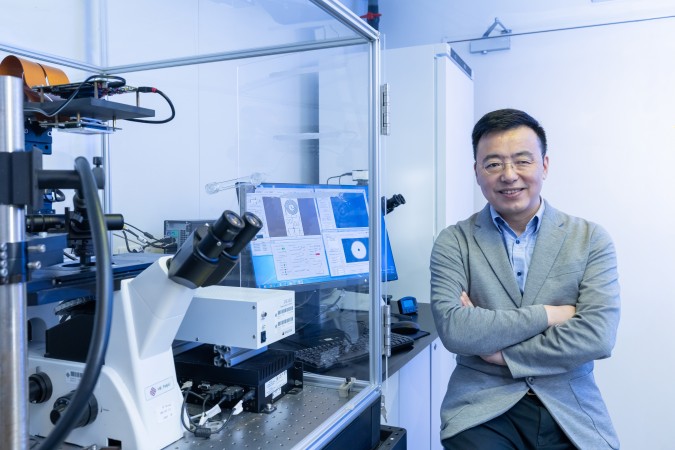Novel 3D microlaser sensor and tetrandrine mechanism unlock early disease detection and targeted therapies
Researchers at PolyU have achieved major breakthroughs in biomedical science with two innovative studies poised to transform early disease detection and targeted therapies for viral infections and neurodegenerative diseases.
The first breakthrough is a novel 3D micro-printed whispering-gallery-mode (WGM) microcavity sensor, developed by Professor Zhang A-ping, Professor of the Department of Electrical and Electronic Engineering. The Limacon-shaped microcavity sensor combines flexible 3D micro-printing with the optical advantages of WGM microlasers, overcoming previous challenges in light input and output for biosensing. Unlike conventional sensors that require fragile tapered optical fibres, this new design emits directional light directly, enabling easy integration into lab-on-a-chip platforms.
Highly sensitive, this microlaser sensor detects disease biomarkers at attogram-permillilitre levels—demonstrated by its ability to measure human immunoglobulin G (IgG). Such sensitivity could revolutionise early diagnosis of diseases like cancers and Alzheimer’s, as well as enable rapid responses to global health crises such as COVID-19. Professor Zhang envisions integrating these sensors within microfluidic chips for simultaneous, quantitative detection of multiple biomarkers, advancing point-of-care medical diagnostics. The research, “3D micro-printed polymer Limacon-shaped whispering-gallery-mode microlaser sensors for label-free biodetection”, has been published in Optics Letters, and highlighted with a news release by the international optical society OPTICA.

Prof. Zhang remarked that the innovative microlaser sensor was made possible by PolyU’s in-house 3D micro-printing technology, which allowed for the rapid fabrication of the specially designed 3D WGM microcavity and high-precision trimming of its suspended microdisk.
The second breakthrough, led by Professor Ben Ko Chi-bun, Associate Professor of the Department of Applied Biology and Chemical Technology, uncovered the mechanism of tetrandrine, a compound extracted from the traditional Chinese medicine Stephania tetrandra. Using advanced photoaffinity probes and multi-omics analysis, the team found that tetrandrine binds to lysosomal integral membrane protein type-2 (LIMP-2), blocking sphingosine discharge and regulating calcium channels crucial for immune response, metabolism, and viral replication.
This mechanism disrupts viral entry and replication, notably against Ebola and COVID-19 viruses, and opens new avenues for treating diseases related to calcium imbalance, including neurodegenerative conditions like Alzheimer’s and Parkinson’s and certain cancers. The findings have been published in Nature Communications, in a paper titled “Tetrandrine regulates NAADP-mediated calcium signaling through a LIMP-2-dependent and sphingosine-mediated mechanism”.

Prof. Ko stated that this study is the first to uncover LIMP-2’s role in calcium signalling, uncovering a novel pathway for NAADP-regulated signalling through LIMP-2 and sphingosine. Additionally, it identifies LIMP-2 as a crucial target for tetrandrine in treating Ebola virus infection, with potential implications for other antiviral therapies.
These studies exemplify PolyU’s multidisciplinary approach, combining cutting-edge technologies with science to spearhead next-generation medicine. The microlaser sensors empower early, precise detection of diseases at the biomolecular level, while the tetrandrine research elucidates novel biological pathways for therapeutic intervention. This dual advancement highlights the synergy of modern engineering and molecular biology, marking a leap towards more effective treatments and diagnostics in global health.






